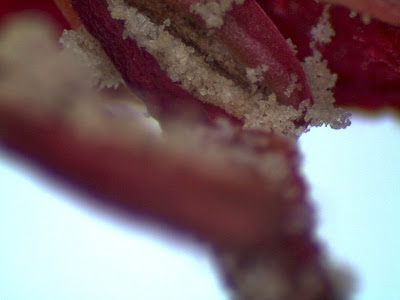For our Procedure there were numerous stations to work at, our group started on station 8.
Station 8: Compound Microscope
Step 1: Gather all the plant samples. (Fushia, Daisy and Cedar), Stub, Compressed air can.
Step 2: Pick up the Fushia sample, and go over it with a brush. Try to attract pollen onto the brush.
Step 3: Look for pollen on the brush.
Step 4: If neccasary look at the brush under the microscope to search for pollen.
Step 5: Once the pollen is found on the brush, pick up the stub with care and place the Fushia pollen on the first fiduciary mark of the stub.
Step 6: Pick up the Daisy sample, and go over it with the brush as well. Try to attract pollen onto the brush.
Step 7: Look for pollen on the brush.
Step 8: If necessary look at the brush under the microscope to search for pollen.
Step 9: Once the pollen is found on the brush, pick up the stub with care and place the Daisy pollen on the second fiduciary mark of the stub.
Step 10: Pick up the Cedar sample, and go over it with a brush. Try to attract pollen onto the brush.
Step 11: Look for pollen on the brush.
Step 12: If necessary look at the brush under the microscope to search for pollen.
Step 13: Once the pollen has been found on the brush, pick up the stub with care and place it on the third fiduciary mark of the stub.
Step 14: Pick up the stub and the compressed air can.
Step 15: Spray the stub with the compressed air, although it is important to carefully spray it with a distance of about 2 feet. Be carefully to not, blow off the pollen samples off the stub.
Step 16: Label the stub with the initials of all the group members.
Station 1: Leica Stereo Microscope Digital Pictures
Step 1: Gather all samples, (Daisy, Fushia, and Cedar).
Step 2: Place the Fushia sample under the microscope.
Step 3: Capture the image of the sample, at the standard magnification of (35X).
Step 4: Label the name of the picture, title it with the species name.
Step 5: Label the picture with the magnification size as well.
Step 6: Go to settings and Include a scale on the image for measurements.
Step 7: After this point save the information for the picture.
Step 8: Place the Daisy sample under the microscope.
Step 9: Capture the image of the sample, at the standard magnification of (35X).
Step 10: Label the name of the picture, title it with the species name.
Step 11: Label the picture with the magnification size as well.
Step 12: Go to settings and include a scale on the image for measurements.
Step 13: After this point save the information for the picture.
Step 14: Place the Cedar sample under the microscope.
Step 15: Capture the image of the sample, at the standard magnification of (35X).
Step 16: Label the name of the picture, title it with the species name.
Step 17: Label the picture with the magnification size as well.
Step 18: Go to settings and include a scale on the image for measurements.
Step 19:After this point save the information for the picture.
(Optional): Take more pictures of the samples to have a variety of different angles. Repeat the same steps.
Station 5 & 6: SEM Microscope
Step 1: Gather all the materials (Stub, Carbon tape, Compressed air can).
Step 2: Have the sample ready because it is very sticky.
Step 3: Carefully connect the stub with the carbon tape.
Step 4: Divide the stub into 3's, there will be different pollens in each divided stub.
Step 5: Label your group's stub.
Step 6: Blow the sample with the compressed air.
Step 7: Place the stub into the cup of the SEM.
Step 8: Spin the cup to the left, until it is flushed. (May have to eye it).
Step 9: Spin four times to the right.
Step 10: Push the cup all the way into the SEM, until the green light comes on.
Step 11: Push down on the door, in order to close it.
Step 12: Map it.
Step 13: Go to settings
Step 14: Go to label, and label the name of the plant, Period 7, the first initials of group members).
Step 15: Save the name.
Step 16: Press "OK".
Step 17: Go to image.
Step 18: Hit the plus button which will create raccum.
Step 19: To improve your image, zoom in or focus.
Step 20: Turn nob to the right.
Step 21: Focus the image.
Step 22: Press the camera button to take pictures.
Step 23: Go to the archive to see all of the pictures.
Step 24: Click on the ruler button.
Step 25: Click on the left side.
Step 26: Then click on the right.
Step 27: Take the picture.
Step 28: Save the picture.
Step 29: Press the eject button.
Step 30: Wait for it to unlock.
Step 31: Take the cup out very carefully.
Step 32: Twist up the cup.
(WARNING)
1. No moisture is allowed. (Including water).
2. No magnetics.
3. Have to blow off the samples.
4. Spin the cup four times to the right.





















